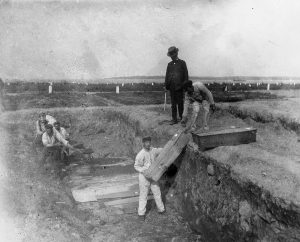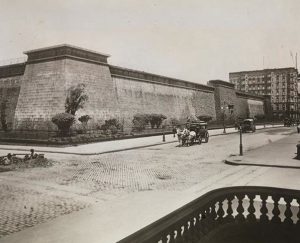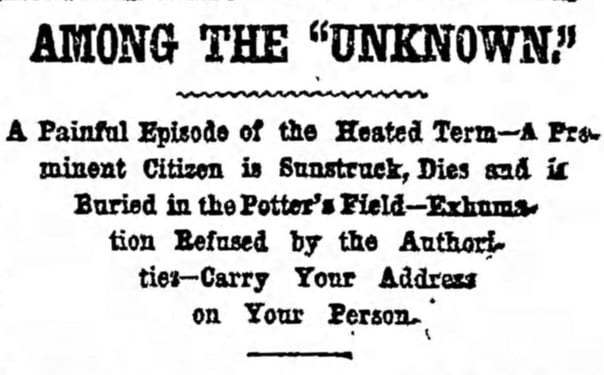“We are the clay, you are the potter; we are all the work of your hand.” – Isaiah 64: 8
Recently, I was researching a case for a client whose ancestors had roots in Sullivan County, New York during the late eighteenth and early nineteenth centuries. Locating New York records from any period presents a near perpetual brick wall. I had few clues with which to assemble this report.
According to the New York Death Register of Manhattan, my subject, John Gray, died from delirium at a city hospital in 1829 at age 41. From evidence furnished to us by the client, he was married nine years prior, probably near Liberty, in Sullivan County. The death register noted that he is buried in “Potter’s Field.” Discovering the whereabouts of burial for my subject could help lead to more details about the family, especially if some are interred with him.
I have not come across the term “potter’s field” in genealogy before this and assumed that it was the name of the cemetery.
 “A trench at the Potter’s Field at Hart Island,” circa 1890. Jacob Riis Collection © Museum of the City of New York
“A trench at the Potter’s Field at Hart Island,” circa 1890. Jacob Riis Collection © Museum of the City of New York
Two sources were returned from my search for a place of interment by this name. The first is the “Potter’s Field” cemetery located in Valhalla, Westchester County, New York. This location is a possibility, though Westchester is across the Hudson River from Sullivan County and not exactly a match for this family, geographically. The second result is for a cemetery on Hart Island off The Bronx. Hart Island is a public cemetery, and one of the country’s largest burial grounds. This cemetery allows visitors one Thursday and one Saturday per month following an application process that begins six months prior to a scheduled visit.[1]
More than 1 million bodies, mostly impoverished or unclaimed persons, have been buried at Hart Island since 1869. It is said that, in eight to ten years, the island will be at capacity.[2] The island is closely guarded due to its operation and caretaking by the New York Department of Corrections; Riker’s Island inmates bury the dead. Because the first year of interment at Hart Island is forty years following the death of my subject, I cannot endorse the location as his place of burial. I continued to investigate where my subject could be interred.
During the research process, I sought to discover more about the sexton noted on the death register for Potter’s Field, “C. Myers.” I was of the mind that the sexton of such a place at such a time must be the landowner of the field. The results returned showed a "Cornelius Myers, Keeper Potters field," a city employee paid $67.50 for the year 1827.[3] While in certain circumstances looking for a place of residence for Cornelius Myers in 1829 New York would be a reasonable pursuit, because he appeared to be a city employee I did not opt for this direction. I instead researched to learn more about these mass graves and where they would be located during this decade in Manhattan.
Potter’s fields were usually near asylums, churches, almshouses, and “incurables” hospitals.
Like Hart Island, potter’s field burial grounds are generally mass graves for the unnamed or indigent, vagrants and criminals, asylum and prison inmates, the homeless, the poor and, sometimes, people of color. Potter’s fields were usually near asylums, churches, almshouses, and “incurables” hospitals.
The origin of the ancient term has roots in the New Testament, Gospel of Matthew, 27: 8:
When Judas, his betrayer, saw that Jesus was condemned, he repented and brought back the thirty pieces of silver to the chief priests and the elders… Throwing down the pieces of silver in the temple, he departed… [The] chief priests, taking the pieces of silver, said, "It is not lawful to put them into the treasury, since they are blood money." After conferring together, they used them to buy the potter's field as a place to bury foreigners.
Others have found its etymology quite literal. In Manhattan it is said that the only true potter’s field was in an open marsh not far from the Brooklyn Bridge Promenade. The shacks and ovens of potters were built upon the sloping hill to collect water during Colonial times.[4]
Potter’s fields served as the final interments for victims of plagues and epidemics that caused substantial deaths when communities and municipalities had no other locations for the volume and pace at which the numbers accumulated. In 1822, yellow fever swept through the ports of the northeast United States; lower Manhattan became overpopulated with the sick and dying. Nearly each day from August through October that year, The Evening Post reported numerous cases of the virus from the Board of Health. The first case of yellow fever was recorded in the vicinity of Washington and Rector Streets. A block east, the seventeenth-century public burial ground in the Trinity Churchyard was the closest cemetery to the source of the outbreak and the neighborhood where most of the cases were contained. Yet, the churchyard had already accommodated more than a century’s worth of bodies, exceeding 120,000 in number.
By the 1820s, the city’s population had grown twenty-five-fold since the cemetery’s first interment in 1691. This led to a burial crisis in Manhattan, the consequences of which were a persistent stench and the interring of bodies only two to three feet underground[5] to conserve and preserve space. Subsequent legislation passed requiring interment care for residents to be addressed at the county level rather than the town level, as was previously the case.[6] From the peak of yellow fever deaths in 1822 to the end of the decade, county potter’s field locations were in various areas of Manhattan until Hart Island was formed in 1869. In 1829, when my subject John Gray died, the New York County potter’s field was probably at about today’s Fifth Avenue between Fortieth and Forty-second Streets. Though I can never be certain, this could be where John Gray was interred. Or maybe not.
 The Croton Reservoir at Forty-second Street. Courtesy of the Museum of the City of New York via Gothamist
The Croton Reservoir at Forty-second Street. Courtesy of the Museum of the City of New York via Gothamist
Another consequence to New York City’s over-population demands was the need for a public drinking water supply. In 1842, the solution was the construction of the Croton Reservoir, a four-acre, 50-foot high, above-ground lake containing 20 million gallons of water. Its location? Between Fifth Avenue and Forty-second street: the New York County potter’s field.
To begin the massive project, more than 100,000 bodies were exhumed and relocated. First, the interred were transferred to a nearby plot at Fourth Avenue and Fiftieth Street. In 1857, that same plot was designated for the Women’s Hospital;[7] today, the location is occupied by the Waldorf-Astoria Hotel and adjacent buildings.[8] The bodies were then removed to Wards Island,[9] 432 acres of land now conjoined with Randall’s Island, separated from Manhattan by the Harlem River. Once independent masses, it wasn’t until the 1960s, when the City deposited enough construction debris, that the two islands connected.[10]
The Croton Reservoir lived its short life in the potter’s field location for less than 50 years until demolition in 1890. Today, the land is where Bryant Park and the main branch of the New York Public Library stand.
Though I have learned a great deal about potter’s fields, I am not closer to creating a story of John Gray’s life before death, other than to confirm that he suffered and the family around him likely suffered, too. Did his forgotten soul travel through Manhattan a victim of eminent domain, from two midtown locations with a final stop at Wards Island, or does he remain under Bryant Park and the New York Public Library?
The next time I am walking through Bryant Park or visiting the main branch of the public library, I hope I think of John Gray and the other nameless and forgotten below my feet.
*
Burial records for Hart Island can be accessed here: https://data.cityofnewyork.us/City-Government/DOC-Hart-Island-Burial-Records/c39u-es35
Links for New York potter’s fields and Hart Island
https://www.newyorkfamilyhistory.org/blog/kings-county-potter%E2%80%99s-field-forgotten-dead
https://www.smithsonianmag.com/history/what-happens-when-a-homeless-new-yorker-dies-808498/
https://daily.jstor.org/burying-nycs-forgotten-dead-at-hart-island/
https://www.reuters.com/article/us-new-york-graves-idUSKBN1582FM
https://www.boweryboogie.com/2015/06/what-lies-beneath-buried-potters-fields-lower-east-side/
https://gothamist.com/arts-entertainment/photos-a-brooklyn-navy-yard-cemetery-has-become-a-park
Notes
[1] Devin Gannon, “As Hart Island nears capacity, city seeks new public cemetery sites,” 6sqft: Bronx, Policy, https://www.6sqft.com/as-hart-island-nears-capacity-city-seeks-new-public-cemetery-sites/ (25 September 2019): accessed 29 September 2019.
[2] Ibid.
[3] Minutes of the Common Council of the City of New York, 1784-1813, vol. 16 (City of New York, 1917), p. 546, in Googlebooks: accessed 25 September 2019.
[4] Margaret F. O’ Connell, “Potter’s Field Has Found a Resting Place at Last,” The New York Times, online archives, https://www.nytimes.com/1975/08/31/archives/potters-field-has-found-a-resting-place-at-last-a-resting-place-for.html (31 August 1975): accessed 30 September 2019.
[5] Casey Hedstrom. “The Manhattan Burial Crisis of 1822 Makes Every Cemetery Today Seem Amazing,” Atlas Obscura, https://www.atlasobscura.com/articles/the-manhattan-burial-crisis-of-1822-makes-every-cemetery-today-seem-amazing (22 October 2015): accessed 29 September 2019.
[6] Mary French, “Kings County Cemetery,” New York City Cemetery Project: Kings County Cemetery, https://nycemetery.wordpress.com/2018/12/13/kings-county-cemetery/ (13 December 2018): accessed 30 September 2019.
[7] New York Society Correction History, “Potter’s Field”, correctionhistory.org, http://www.correctionhistory.org/html/chronicl/hart/html/hartbook2.html (publication date unknown): accessed 8 October 2019.
[8] Potter’s Field (Fiftieth Street), findagrave.com, https://www.findagrave.com/cemetery/2561366/potter%E2%80%99s-field-(fiftieth-street) (29 November 2014): accessed 8 October 2019.
[9] Jen Carlson, “This Massive Reservoir Used to be Midtown,” Gothamist, https://gothamist.com/arts-entertainment/this-massive-reservoir-used-to-be-in-midtown (16 January 2015): accessed 8 October 2019.
[10] Bess Lovejoy. “Islands of the Undesirables,“ Randall’s Island and Wards Island, atlasobscura.com, https://www.atlasobscura.com/articles/islands-of-the-undesirables-randall-s-island-and-wards-island (2 June 2015): accessed 7 October 2019.
Share this:

About Susan Donnelly
Susan is a native New Englander and second generation American from a large extended family of artists. She spent two years with the Research Services team, working on several large projects, before joining Newbury Street Press. Prior to NEHGS, Susan was the director and auction coordinator with a premier antique gallery in Boston for two decades and an archival volunteer with the Hingham Historical Society. She received her B.A. in English Literature from Simmons College and holds a Professional Certificate in Genealogy from Boston University. Her research interests include Colonial America, royal ancestry, westward expansion, and U.S. migration trails. Susan is a photographer and potter and collects mid-century modern art.View all posts by Susan Donnelly →
